
Increasing supply of new hotel rooms in major cities is impacting occupancy but not by much, according to the latest STR hotel performance data released today.
Demand in the major capitals is beginning to neutralise the impact of hundreds of new rooms which opened in the preceding year, the data shows, with the gaps between Rooms Available and Rooms Sold far narrower than anticipated. This market recovery saw these hotels able to improve their daily rates (ADR) to boost yield.
ADR was generally a mixed bag for the month of January. While cities such as Adelaide (-2.4 per cent) and Sydney (-3.9 per cent) posted declines, most other major centres saw improvements, with Melbourne a noted improver (+2.7 per cent). However, results in the Victorian capital were not quite as positive as they could have been, having hosted the Australian Open tennis grand slam during the month, with occupancy down 2.3 per cent to 78.3 per cent.
Australia’s standout city for the month of January was Hobart, which is riding a wave of momentum during the pleasant warmer months. The Tasmanian capital closed at 92.5 per cent occupancy with an Average Daily Rate of AUD$209.80. RevPAR was a major success, climbing from $176.83 a year earlier to $194.05 for January 2019 – a 9.7 per cent improvement.
“Across Australia, more rooms were sold than January 2018 and by the major markets, only Cairns and Darwin saw fewer rooms sold,” an STR spokesperson told HM.
“But as has been reported, new supply is weighing on occupancy and therefore, occupancy is slightly lower in many Australian cities. Darwin continues to unwind the INPEX related room demand, reporting a 29.3 per cent decline in demand with 41.3 per cent occupancy. The average rate was flat on year over year comparison falling only 0.8 per cent to $116.03.”

